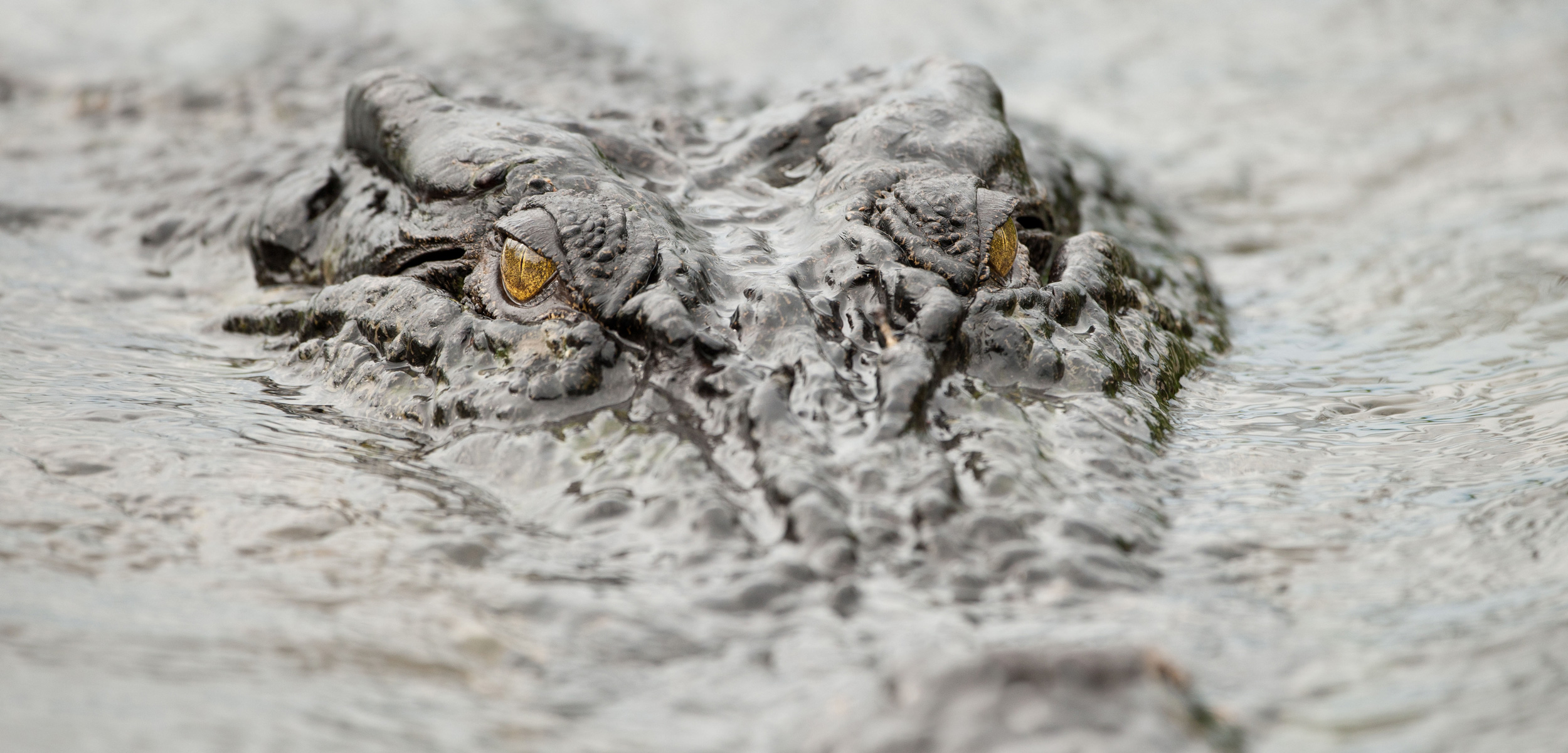Crocodiles Rising
In the Northern Territory of Australia, policymakers and biologists managed the impossible—making the benefits of living with a booming population of deadly crocodiles outweigh the risks. But when two apex predators must share coastal resources, there’s bound to be conflict.
Article body copy
Congratulations to Shanna Baker on winning a silver award for Best Feature Article: Long from the Digital Publishing Awards for this article.
A saltwater crocodile surges out of the gravy-colored Adelaide River like a malevolent jack-in-the-box, and with a percussive pop! its spring-loaded jaws clamp onto a chunk of raw buffalo meat dangling from a line. A toddler on the boat’s lower deck screams; the people around me suck in air. The crocodile thrashes its head back and forth, gulping down the meal, and then slowly recoils back under the surface, watching as the boat chugs on toward other hungry crocs.
In 2014, on this same stretch of tidal river, where visitors to Darwin in Australia’s Northern Territory (NT) come to watch wild saltwater crocodiles leap for lunch, a fisherman was killed.
A local pointed out the spot as I was waiting for my boat trip. He hurried me down a ramp toward the dock. “Look, there’s one,” he said. On cue, what looked like an old waterlogged chunk of wood floating at the water’s edge resolved into an elongated head. Crocodile. “There’s another one,” he pointed near the end of the dock. “And just over there,” he said, indicating to the opposite muddy bank just upriver, “that’s where the fisherman was taken.” He shook his head. “For a $1.50 fly.”
The man, the coroner’s report clarifies, had waded through the muck at the river’s edge to release a snagged line. As he reached out with a stick, a saltwater crocodile chomped onto his arm. “Chet roi, troi oi!” the man screamed in Vietnamese as he was pulled under the water—“Oh my god, I am dead.” His wife turned in time to see only the flick of the animal’s tail. Later, the crocodile was found in a small channel, the man’s hand and arm dangling from its mouth.

Using the strength of its powerful tail, a saltwater crocodile explodes out of the Adelaide River. Photo by Shanna Baker
Here in the NT’s Top End, the tropical northern region wedged between the Timor Sea and the outback’s dusty rangeland, horror-inducing stories about Crocodylus porosus are in steady supply. Every Territorian, as the people of the NT call themselves, has a mental Rolodex of reported attacks and near misses to draw from. Protective measures followed by a carefully crafted management program have allowed saltwater crocodiles, or salties, in the region to rapidly rebound from near extinction to historical levels over the past 45 years, while giving people incentives to let that happen. Factoring in the farmed population, crocodiles now outnumber humans in the Top End. As many as 100,000 of these legendary predators rule the coastal wetlands. Territorians have done the unthinkable in modern times—they’ve ceded their coastal wilderness to the wild. Wild that can eat you. The strategy for maintaining the crocodile population is sound—but there are cracks. Keeping the relative peace is a constant battle. Now, crocodiles are getting bolder, locals are demanding action, and those who care most about the future of crocs in the Top End hold their breath, wondering if there’ll come a breaking point.
At Crocodylus Park, a hybrid zoo, crocodile farm, and research center with its own man-made river full of adult salties, Darwin’s veteran crocodile researcher, Grahame Webb, sips a coffee and says, “The cold hard reality is you can swim with sharks and do all these death-defying acts. You can feed them with bloody fish in chain mail gloves—well whoopee whoopee-do. You dive into a river here and start swimming and there’s a 100 percent chance you’ll be taken and killed by a crocodile.” He leans back in his faux-crocodile-print chair (not even a croc farmer can justify the expense of the real deal) and re-emphasizes his point: “Not a 50 percent chance—100 percent.” We’re sitting across from each other at a table in a spacious room that he uses to host groups at Crocodylus Park. Over his left shoulder, in the glow of fluorescent lights, a table-length taxidermic croc is frozen on all fours, its jagged mouth wide open. On his right, there’s a menagerie of stuffed African cats—former exotic residents of the zoo. Webb knows crocodiles. He has worked with them extensively since arriving in the NT from Sydney in 1973, fresh from completing his PhD. He’s also the chair of the International Union for Conservation of Nature’s crocodile specialist group and an adjunct professor at Charles Darwin University. And he doesn’t believe there’s any value in sugarcoating the dangers. It’s better, he says, “to let people know exactly what they’re dealing with” and give them sensible reasons to look after the animals.
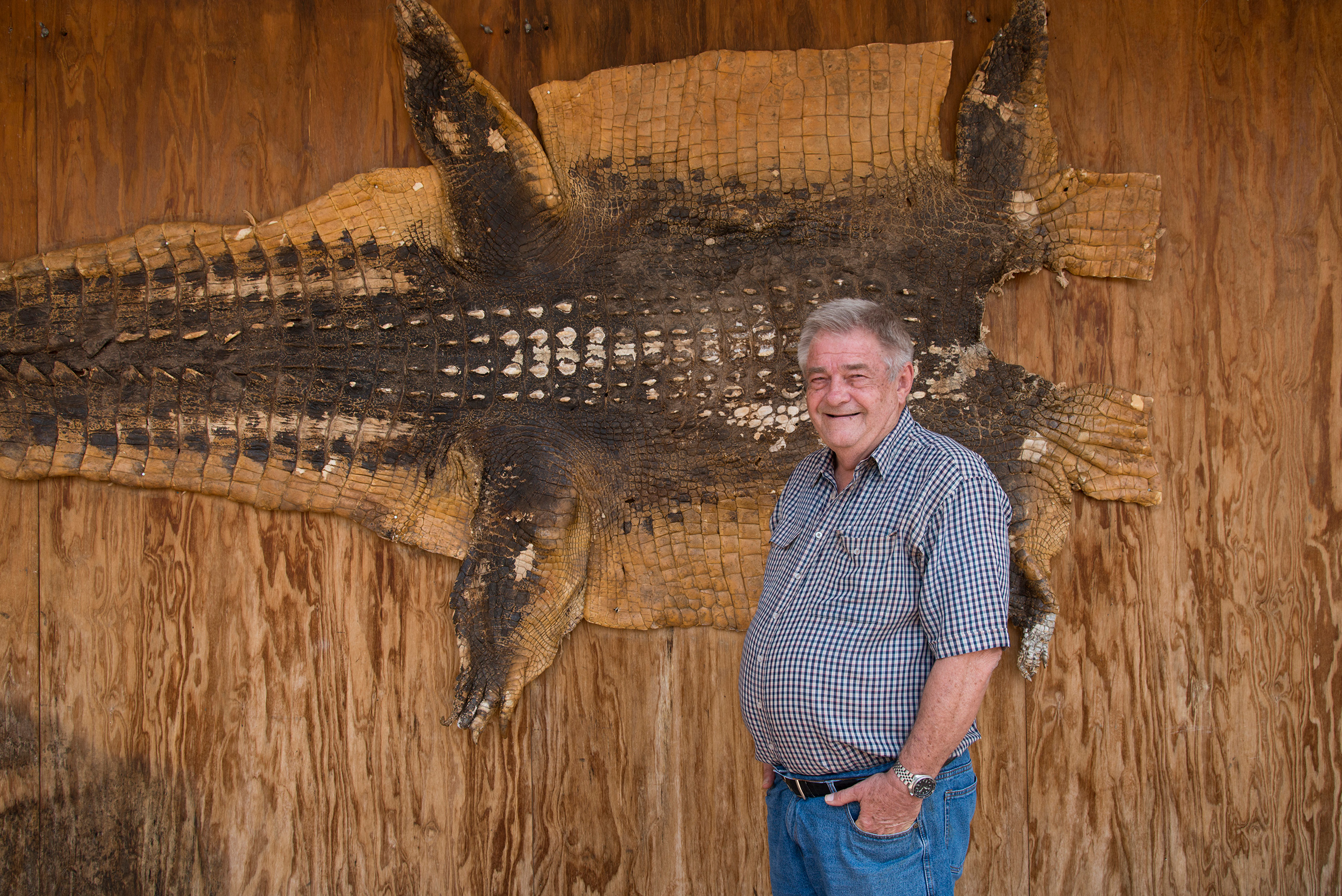
Grahame Webb of Crocodylus Park has studied saltwater crocodiles for more than 40 years and witnessed their recovery. Photo by Shanna Baker
When Webb arrived in the Top End, it was difficult to find a saltwater crocodile. After the Second World War, overzealous hunters had blasted them for skins and didn’t stop even after the supply had collapsed and they were teetering on the edge of extinction. By the time salties were protected in 1971, just three to five percent of the original population remained.
Once salties began recovering, scientists and policymakers were faced with the next big obstacle: convincing people to keep them around. Persuading people to coexist with deadly predators over the long term, Webb asserts, is one of the world’s greatest conservation challenges. It’s easy to get people to rally around a predator when it has nearly vanished and become a romantic notion, but people are fickle: “If protection works in terms of increasing numbers, crocodiles eat more people, and then people want to get rid of them again,” he says. That’s what happened in 1979 and ’80, when crocodiles killed two people and badly injured two others. During the same time, an old crocodile named Sweetheart began flipping tourist fishing boats. The 5.1-meter, 780-kilogram brute—as long as a medium-sized dinosaur—would wrestle with the boat as the panicked passengers swam to shore. Sweetheart had likely mistaken the sound of the motor for the growl of another crocodile, Webb says, but these incidents threatened to unravel the conservation efforts and topple the NT’s nascent tourism industry. For people to willingly tolerate crocodiles, Webb reasons, they need to benefit from the situation—it’s not realistic to expect a community to conserve an animal out of appreciation for its intrinsic value alone.
Inspired by similar programs in Zimbabwe and Louisiana, Webb and his colleagues crafted the NT’s first formal incentive-driven management program in the early 1980s on behalf of the territorial government. It spawned what is now a multifaceted and far-reaching industry that works like this: people drop from helicopters and beat through the swamps to gather wild eggs—roughly 52,000 a year—which they sell to local crocodile farms. (In the wild, egg mortality, often caused by flooding, runs at 75 to 80 percent, and hatchling survival is density dependent, so collecting has no apparent impact on the wild population.) In turn, landowners receive a royalty from egg collection on their property—most harvesting takes place in remote aboriginal communities—which helps compensate them for livestock they lose to crocodiles and motivates them to retain habitat. Farms raise the hatchlings and sell their skins; rangers are employed to manage crocodiles in public areas; and independent permit holders make a living collecting animals from the wild, either for a farm’s breeding program or for trade. It all amounts to an AU $25-million industry.
Salties also play a significant role in the NT’s $1.61-billion tourism industry—the biggest employer in the region. Visitors pose for cheesy photos with hatchlings, dip into a croc’s tank within a “cage of death,” watch feedings, take croc-spotting excursions, and shop boutiques and souvenir shops for coveted wallets and belts or kitschy beer cozies and hatbands.
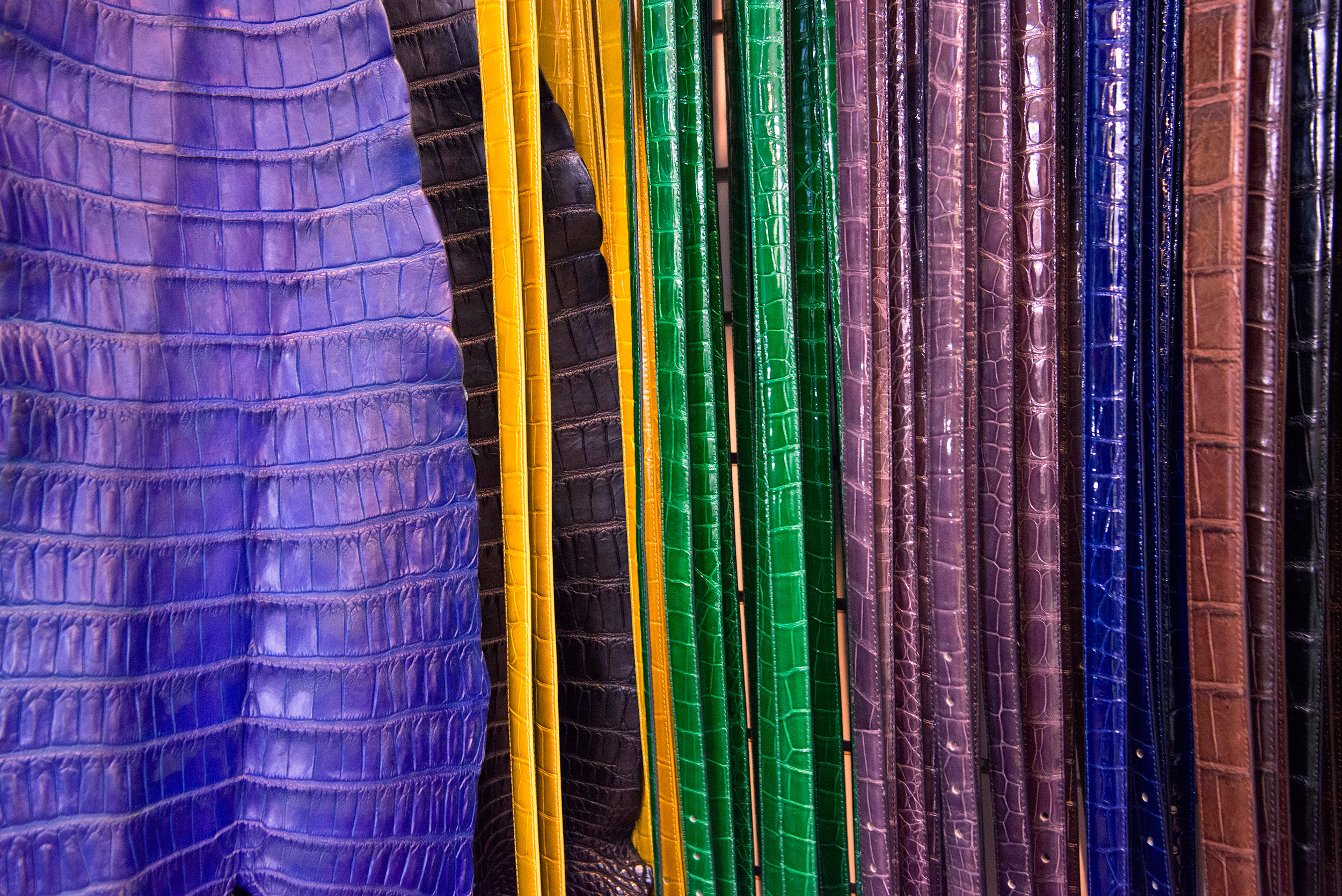
Dyed crocodile-skin belts hang in a gift shop. Saltwater crocodile skin is the most valuable of any crocodile. Photo by Shanna Baker
It can be difficult for an animal lover to accept that sacrificing individual animals is good for the species overall, or to, say, look at a crocodile-skin handbag worth more than the average worker’s annual income and wrestle with the idea that it actually supports rather than harms crocodiles at large. But the success of the sustainable-use program is undeniable. Scientists believe crocodiles have fully recovered and the system is at, or very close to, carrying capacity. Salties are showing up in spots researchers have never seen them before; some have even pushed a staggering 300 kilometers inland, into territory that was once the domain of the region’s smaller and often-overlooked crocodile—the freshie, or freshwater croc, which poses little danger to people and is less entwined in the economy and culture. Saltwater crocodiles are distributed from Sri Lanka and eastern India through most of coastal southeast Asia to Australia’s Top End, but the Aussie population, which extends into neighboring Queensland and Western Australia, is a stronghold.
“People understand that whether they like or dislike crocodiles is irrelevant,” says Webb. “They are an important economic asset for the north. So we’re winning. The people are winning because we’ve created an environment where it’s possible to forgive crocodiles.”
As crocodiles push their boundaries, so does the human population. Greater Darwin, with 57 percent of the NT’s population, is one of the fastest growing capital cities in Australia. Attacks on people are still blessedly rare, but the danger is ever-present and will only increase as the two super-predators get pushed closer together.
“Listen, sweetie,” the spiky-haired, gum-chewing taxi driver who dropped me off at Crocodylus Park said when I asked his opinion on crocodiles. “All I know is, I’ve been here 10 or 12 years, and I can’t go to the swimming holes I used to swim in. And these places are magical, just pristine. People are losing out.”
Fat droplets of rain stain my notebook and ping off my forehead as senior wildlife ranger Tom Nichols opens the throttle and the aptly named boat Porosus blasts across Darwin Harbour. Though crocodiles have the run of the Top End’s river systems, they are unwelcome in the harbor, where the chance for conflict is too great. The five-person crocodile management unit of the NT’s Parks and Wildlife Commission pulls as many as they can find out of the harbor each year—usually between 250 and 300, most of them males an average of 2.4 meters long, though some as long as 4.9 meters. Today, Nichols and ranger Luke McLaren are checking and re-baiting 10 of the 26 metal or aluminum traps spread out at the sides of various creek systems.
“Saltwater crocodile” is a bit of a misnomer, anyway. Crocodylus porosus has special adaptations to tolerate salt water and uses the coast as a thoroughfare, but tends to occupy the tidal and freshwater rivers, swamps, and other wetlands of floodplains. Crocodiles found in the harbor have generally been pushed out by more dominant animals and are searching for a new place to live.
As we close in on the third trap, anchored in a silty, mangrove-lined inlet, we can see the trapdoor is shut. The prisoner lifts its head as Nichols sidles the boat up to it. Occasionally, other boaters release trapped crocodiles before the management team can arrive, whether as an act of mischief or activism or empathy, Nichols isn’t sure. “There are always some people who don’t like what we’re doing,” he says with a shrug. (There seems to be only one consistent and vocal animal rights activist in Darwin, and she ignored my multiple attempts to connect with her.)
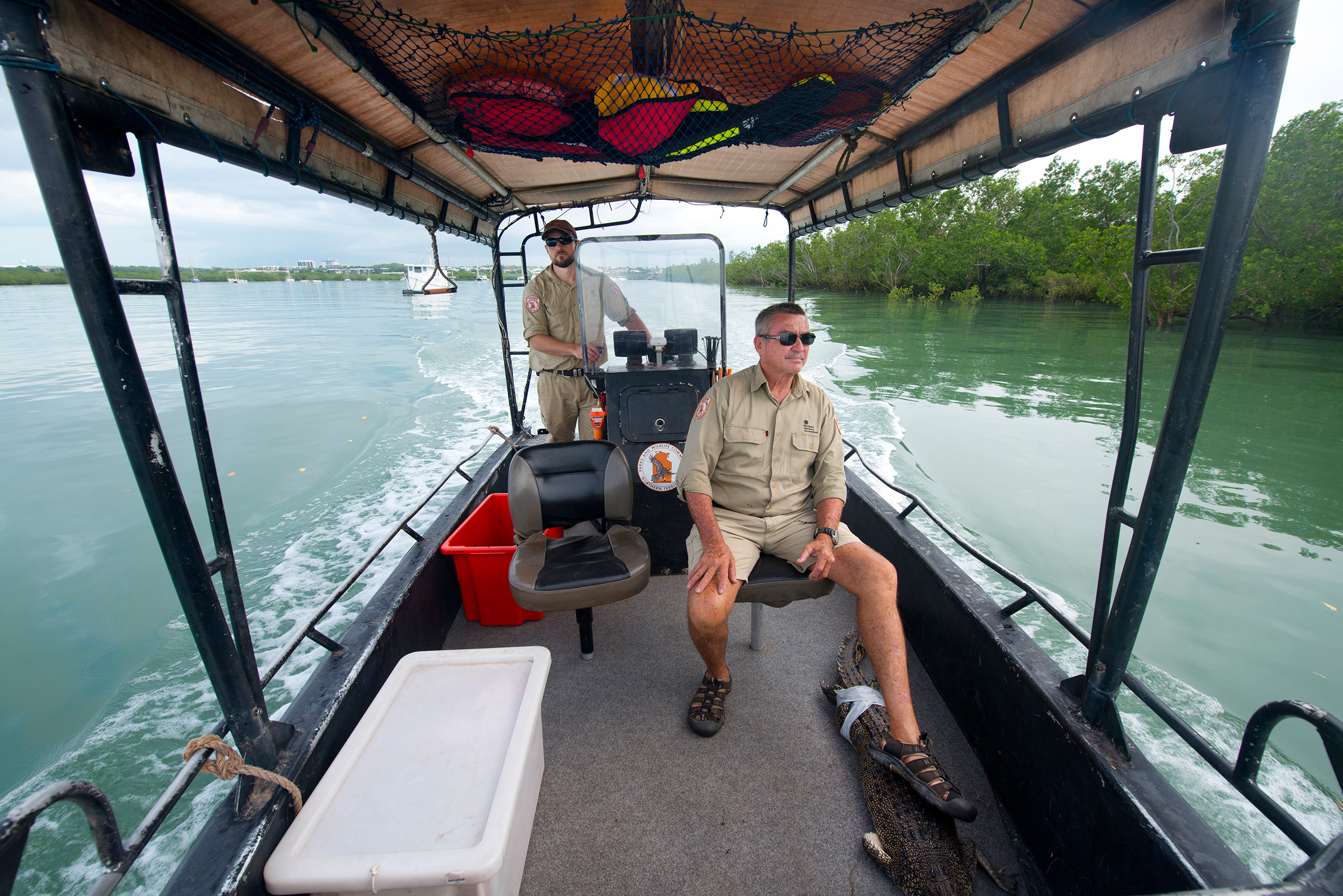
Luke McLaren, at the controls, and Tom Nichols travel around Darwin’s harbor, checking and re-baiting crocodile traps, with one captive on board. Photo by Shanna Baker
McLaren steps onto the trap, opens the hatch, and chases the animal around for a few minutes, guiding it with a pole, until he can slip a lasso over its top jaw. Then Nichols cinches the croc’s mouth shut with a zip tie. The two men pull it up through the top of the trap and, with the practiced precision of a couple of New York City hitmen, wrap duct tape around its snout and back legs, and place a wet cloth over its eyes to help calm it. Within a few minutes, the prisoner is lying on the boat’s floor, its snout tied to a metal cleat. As McLaren re-baits the trap with a chunk of stinking feral pig, complete with blood, bones, and bristles, I run my fingers over the rigid scutes and armor of the crocodile’s back and tail.
Salties can get bigger closer to the equator, but in the Australian wild, the females average about 3 meters and 80 kilograms and males about 4.3 meters and 350 kilograms, but can exceed 5.5 meters. Occasionally, the captives are so big their tails hang off the end of Porosus. Taped up and blindfolded, this one, just a foot longer than I’d be if I lay beside it, is a sorry sight. “He’s pretty small,” I say to McLaren.
“Yes, but he’ll get bigger.”
Captured crocs aren’t relocated in the wild because they have a strong homing instinct, so this will be a one-way trip to the farm. “You’ll be a wallet some day,” I murmur.
Saltie skins are the most valuable of any crocodile. Designers favor the small scales of their bellies and use them in their highest-end products—one luxury Hermès handbag sold for a staggering US $200,000. Once the belly skin is spoken for, the ridged back straps become casual belts and hatbands, the feet become grisly key rings and backscratchers, teeth are turned into necklace pendants or other adornments, and skulls are sold as collectibles. A croc, or parts of it, can also be preserved through taxidermy. The meat is a byproduct, tough and tasteless—as one reliable source puts it, “Crocodile meat is shit”—yet there is an export market for it. Australia shipped roughly 80 tonnes of meat between 2011 and 2013, mostly to Canada, Japan, Malaysia, New Zealand, and the United States.
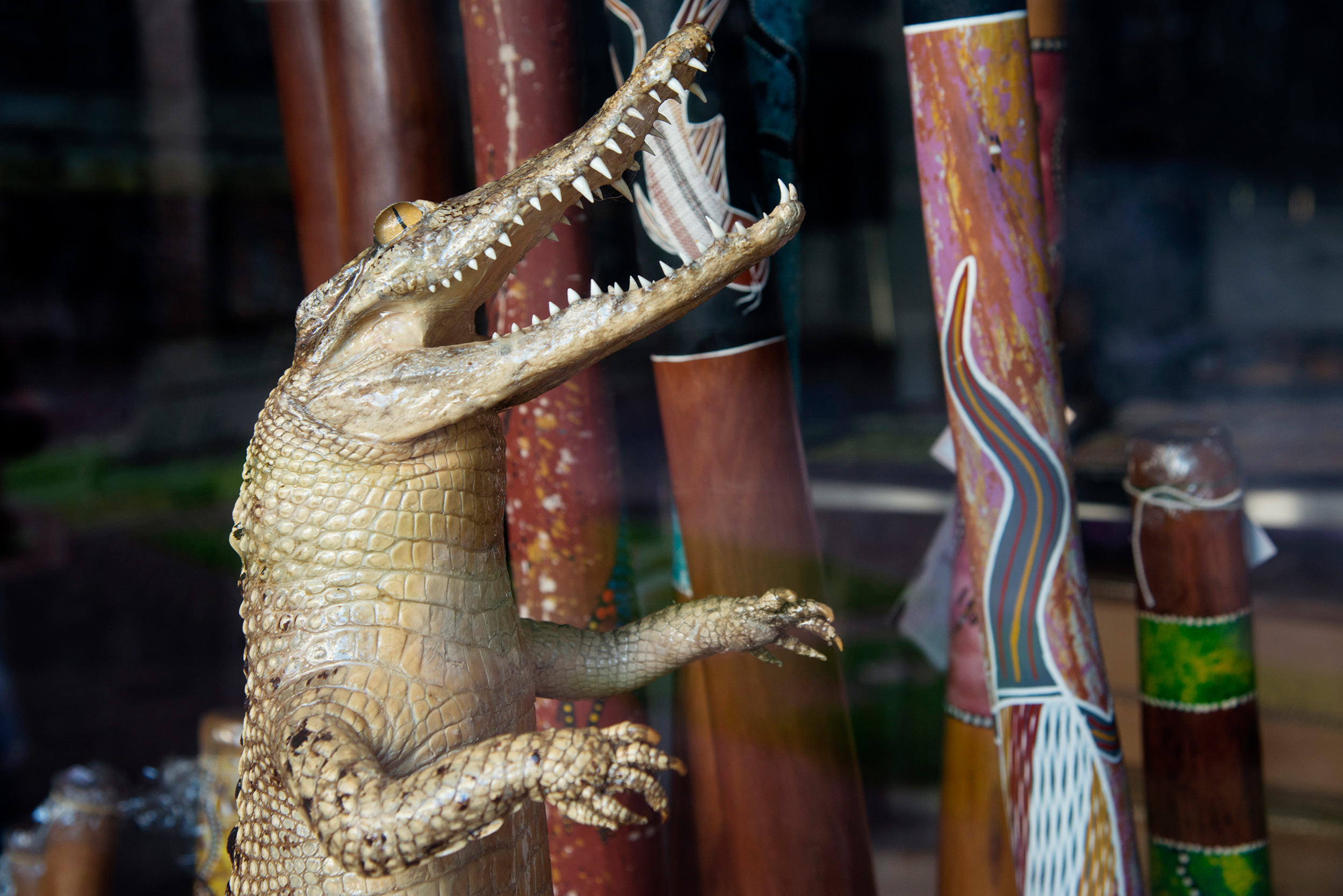
Visitors to Darwin can buy all sorts of crocodile souvenirs, from designer jewelry, bags, and belts to teeth pendants, beer cozies, and taxidermic animals. Photo by Shanna Baker
With the prisoner on board, McLaren takes the helm and continues the rounds. There’s a liquid natural gas plant nearby and the city’s waterfront is developed, yet the harbor is surprisingly wild, with 93 percent of its mangrove forest still intact.
“This is where I lost my hand,” Nichols says, as we pull into Sadgroves Creek past a cluster of liveaboard boats. Two fingers and a crescent-shaped chunk of the ranger’s left hand are noticeably missing. He was retrieving a croc from a trap 13 years ago when the animal snapped onto his pinkie and ring finger and then corkscrewed its body, ripping them off. Nicols paused for a photograph with his fingers protruding from the crocodile’s mouth before prying them out and driving himself to the nearest boat dock to meet an ambulance.
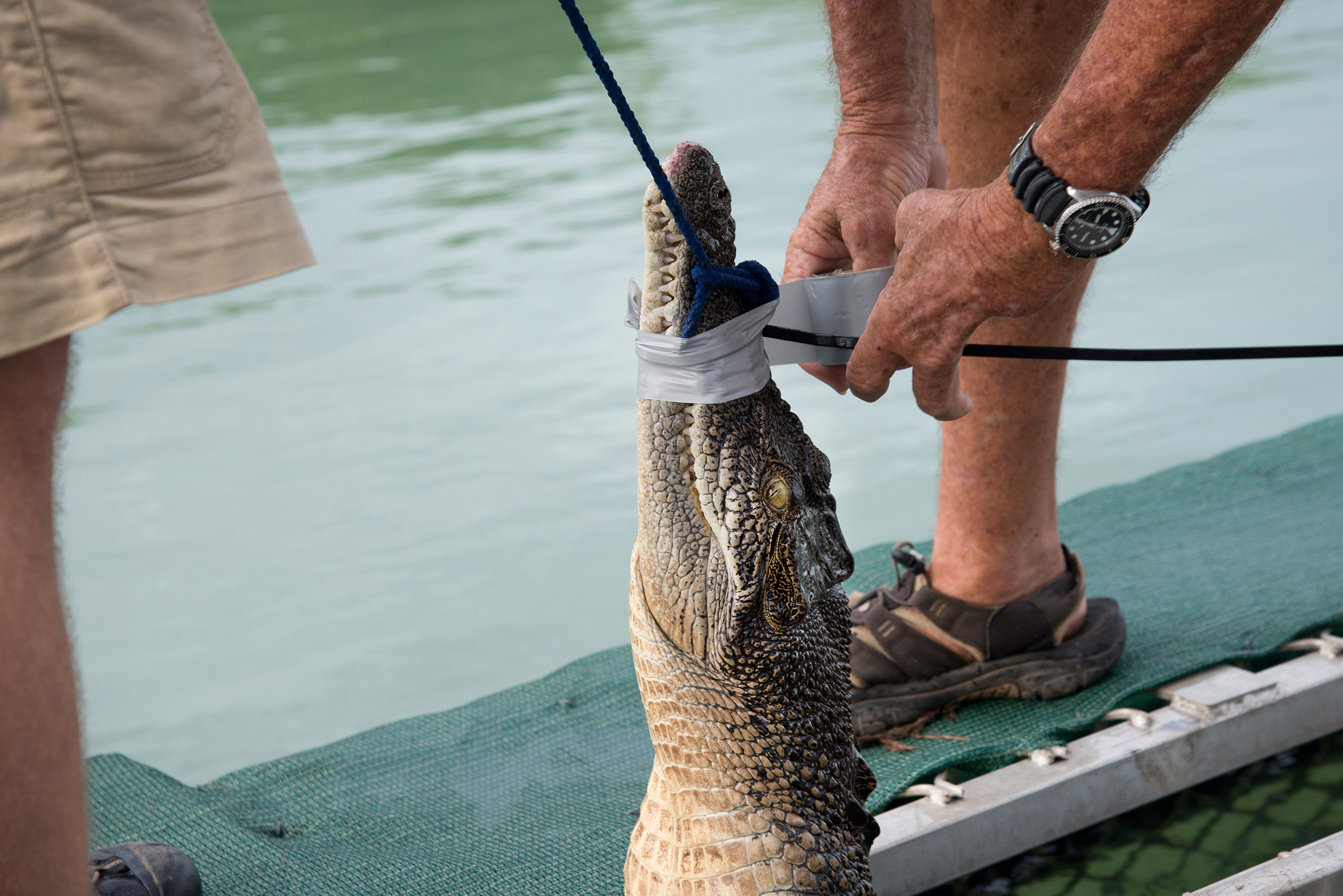
Members of the crocodile management unit of the NT’s Parks and Wildlife Commission tape shut the snout of a small saltwater crocodile trapped in Darwin’s harbor. Photo by Shanna Baker
“What’s your best chance at surviving an attack?” I ask, as we wait for McLaren to add fresh bait to the Sadgroves Creek trap and I try to appear nonchalant while I scan the water around us. “It depends where you’re bitten. Poke them in the eyes if you can, but other times you just have to put your head between your legs and kiss your ass goodbye.”
Darwin, the hub of the sparsely populated Northern Territory, is humble for a capital. Japanese forces annihilated it during the Second World War, and in 1974, Cyclone Tracy kicked it down again. A lot of the buildings are squat and boxy in classic ’70s style. With its bright colors, esplanades, and baking heat, the city has the vibe of a beach town, despite the fact that the beautiful arcing beaches are mostly empty. William Saalfeld, senior scientist with the NT’s Wildlife Use and Pest Animals section in the Department of Land Resource Management, points out that within the known range of Australian salties, which extends as far inland as Katherine, 300 kilometers from Darwin, “there’s not a single water body—not just a river—not a single water body where you could say it’s safe to enter the water.”
Crocodiles are only one deterrent for would-be ocean swimmers; there are also lethal jellyfish and tiger sharks. Some people dare to enter the ocean anyway outside of “stinger” season—Darwin even has a waterski club, ironically with a croc on skis as its logo—but most would rather not take the risk. “There’s a saying up here,” says Nichols. “‘If it doesn’t have tiles, don’t swim in it.’ But even then, you can get crocodiles in your pool.”
It’s early December, the start of the wet season, and the days are swelteringly hot and humid. Every third SUV that drives by me has a snorkel—a pipe raised up like an elephant’s trunk to keep water out of the engine. The intense rains can quickly turn roads into wetlands. Some people even like to fish out the back of their vehicles as they slosh along. The main flock of tourists is long gone, leaving the city feeling underpopulated. The remaining visitors stroll Mitchell Street, the main drag, in flip-flops and sleeveless tops and mingle over pints of beer along a stretch of open-air pubs.

Mitchell Street is downtown Darwin’s hub, where you can always find someone with a crocodile story to share. Photo by Shanna Baker
In this multicultural little city, Territorians like to describe themselves as laid-back, and many of them extend their easygoing attitude to their reptilian neighbors: “They were here before us,” is a common refrain.
But the relationship is more nuanced than that. Crocodiles have come to define the Top End. They’re integral to the cultural identity and are as much a source of pride as a source of anxiety—like being married to a race car driver, or keeping a pet wolf. Though Darwin isn’t the wild frontier town it once was, Andrew Campbell, the director of the Research Institute for the Environment and Livelihoods at Charles Darwin University, who moved here five years ago, believes the old saying still applies: the Top End is for “missionaries, mercenaries, and misfits,” a place where adventurers and antiestablishment types can dodge crowds and stifling rules hundreds of kilometers away from the country’s corporate and political hubs. “You can do your own thing up here and a high level of eccentricity will be not just tolerated, but almost celebrated at times.” In the sparsely populated and untamed region prone to apocalyptic weather, people have the sense they’re living on the edge—and wild roaming saltwater crocodiles fit nicely into that mystique. “So the movie Crocodile Dundee, that’s very much how people see themselves still, some of them,” Campbell says. “Even though they might live quite a comfortable suburban existence, in the back of their minds they’re still Crocodile Dundee.”
As for the aboriginal residents, who make up 27 percent of the NT’s population, attitudes vary—for some, crocodiles are totems or the embodiment of relatives, and others would prefer they disappeared.
If anyone embodies the wild, eccentric frontiersman, it’s Mick Pitman. The sinewy and scrappy 58-year-old who goes by “Crocodile Mick” is one of a handful of private operators who specializes in big “problem” crocodile removal—he and other Territorians with permits can collectively take up to 1,200 animals from the wild in a year. He’s been hunting crocodiles for 37 years, since long before it was legal. He lived in the bush in Queensland for years and learned how to tan skins with bark tannins the traditional way. He still performs taxidermy on the animals he harvests, or tans and sews the skins into wallets and other items that he sells direct to customers.
Pitman and his wife, Michaela Johnston, are outspoken advocates for crocodile safari hunting. They already bring guests out to the bush with them, but want permission for the client to be able to shoot and kill an animal. Safari hunting is a way of turning problem crocodiles into a greater commodity, with proceeds trickling back into the community, they reason. For a time, it looked like they might be allowed—the NT government supported it, with rigorous restrictions, but the federal minister vetoed the idea.
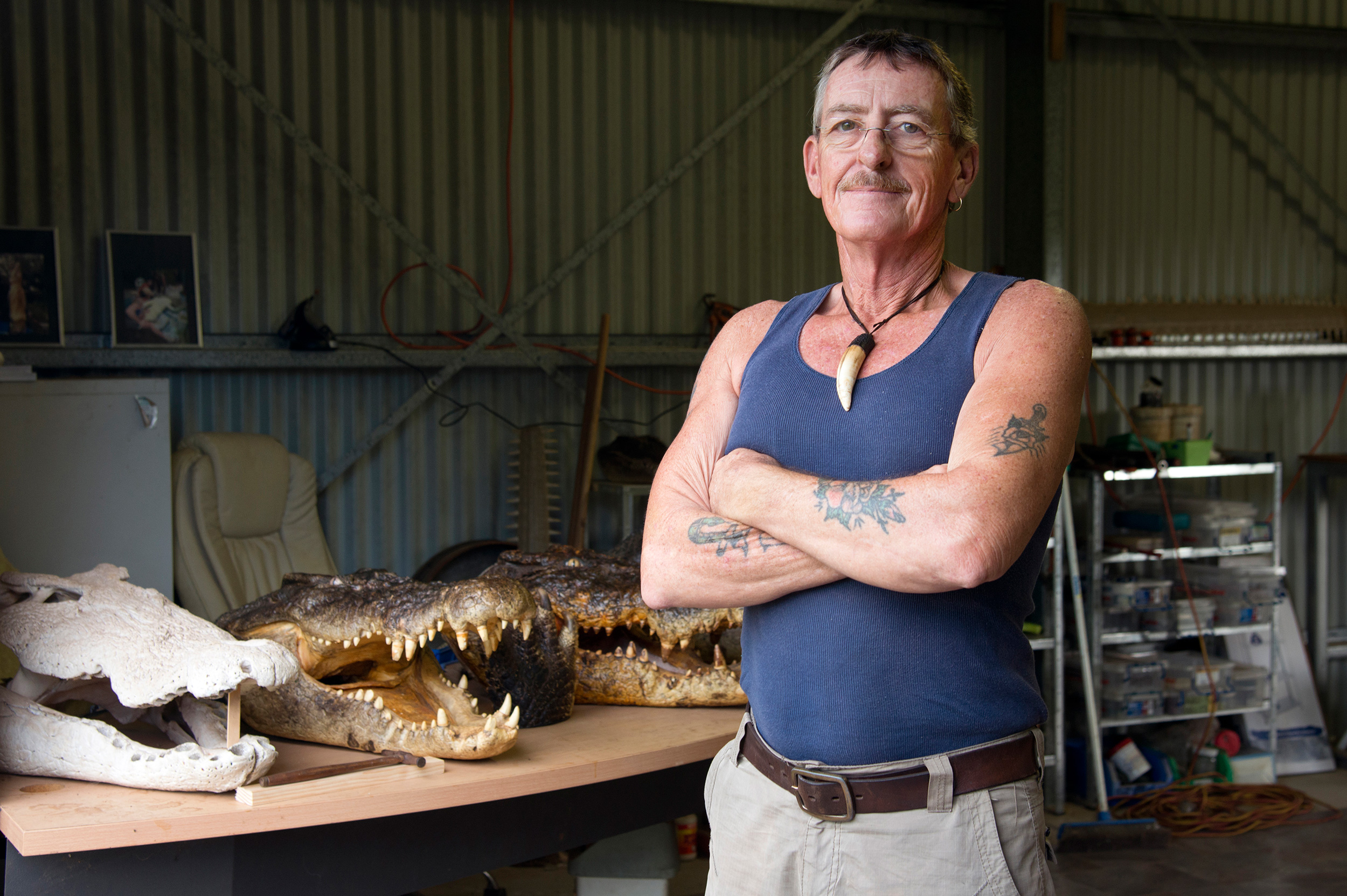
Mick Pitman is one of a handful of independent crocodile-removal specialists in the Northern Territory and processes the animals he catches into products for sale. Photo by Shanna Baker
Pitman, who wears a croc tooth as long as a switchblade on a leather string—from the crocodile that ate his dog—and Johnston, with a sleek ponytail and a cascade of delicate gold chains around her neck, split a pack of cigarettes as we sit on their breezy veranda at an acreage on the outskirts of Darwin and explain their philosophies on hunting crocodiles. As side notes, they describe the many fights Pitman’s been in, explaining that once he scalped a man with his elbows (“There’s nothing better than fighting and crocodiles”), his plans for the future (“I’ll be retiring when I fall off the bow into a croc’s jaws”), and how they ended up in the NT after a drawn-out dispute with the late Steve Irwin and his family that started over the name “Crocodile Hunter.” Then I follow them along a short path to a workshop and Pitman slides open the door. If crocodiles dream, their nightmares surely take place here. One animal is splayed out like a rug at my feet, another is frozen for eternity in a snarling, crawling position. On a worktable, Pitman has a defleshed skull and three heads all lined up, as big as boulders, in various stages of production. At his workstation are bins full of teeth and fake eyeballs. The freezer on the opposite wall is packed with hatchlings, stacked like bricks. These will be turned into “stuffies” and given away for charity or sold for ornaments.
In some ways, Pitman is like a matador, stepping into an arena to battle against an outsize opponent. I’m curious to know what a man who makes killing crocodiles his life’s work feels about them. Deep-seated animosity that motivates him to wrest life from them? Indifference and an unsentimental sense of duty? A desire to conquer? “I have affection for them. Oh yah, shit yah,” he says. “I hate to kill them.”
For the average Territorian, acceptance of salties is predicated on a flimsy belief that attacks happen because the victim made a fatal error of judgment. The majority of attack victims are local men, and alcohol is often involved. Webb also notes that attacks are increasing among aboriginal people. Many clans still live traditional lifestyles in remote places, yet today’s elders grew up at a time when crocs were still depleted, so may not be teaching an appropriate level of caution.
If the sense of control erodes, if more people start getting attacked without making an egregious mistake, tolerance could quickly dissipate. Examples are already out there. In 2014, a man was filling a bucket off the back of his boat in Kakadu National Park and passing it to someone on shore. The third time he went to fill it, a crocodile knocked into the boat’s keel, rocking it. The man reached out to steady himself against the motor and the croc leapt up, grabbed him, and flicked him into the water. In an earlier incident, a man was sitting on a chair in his boat when a crocodile leapt up and knocked him onto the floor. Once, a croc tried to drag a woman out of a tent along the Daly River. “They are simply being opportunistic animals,” explains Adam Britton, a zoologist who specializes in crocodiles and studies crocodile-human conflict. “If they’re hungry and can position themselves where there’s a good chance of feeding, they’ll usually strike.”
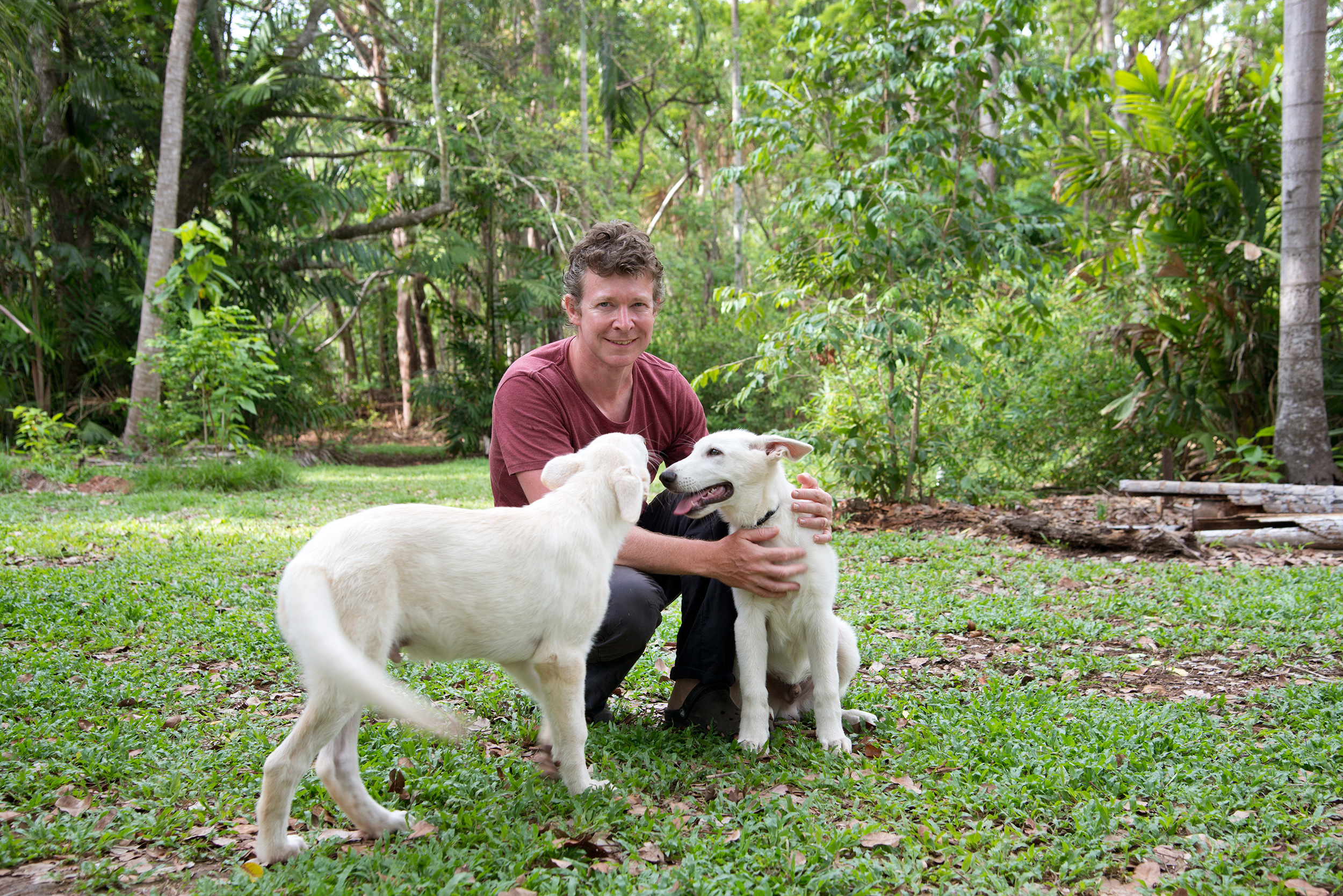
Zoologist Adam Britton is one of the founders of CrocBITE, a new online database of crocodile attacks. Photo by Shanna Baker
Salties can learn patterns quickly, and they’re starting to catch on that fishing boats might equal free meal.
“They’re very friendly,” said a fisherman on the Adelaide River quoted in an article by the Australian Broadcasting Corporation. “Every time I go fishing they come very close and I feed them.”
He’s not the only one deliberately feeding crocodiles, and the animals no longer ignore small fishing boats like they used to. “Every time they do that, they’re teaching the crocodiles it’s a good idea to hang out around people and that emboldens them—they become cheekier,” says Britton. And that, he adds, is the development of “a very dangerous situation.”
It’s a strange feeling to lock eyes with an animal that wants to eat you. As I shift to my left, the crocodile turns his gargantuan head ever so slightly to follow. As I inch back to the right, the head casually, almost imperceptibly, follows. I’m floating close enough to see the red streaks of capillaries in the croc’s eye, close enough to see the wear on its jagged fangs. A minnow swims past, barely an inch from one of the beast’s yellow eyes, but his gaze holds steady on me. His massive body hangs motionless in the water, arcing down so I can see the full extent of his pale underbelly. When I first saw how big he was, a shiver coursed up my spine as if an invisible hand had plucked it like a guitar string. He’s as long as a canoe, but a hell of a lot scarier. Without a metal grate separating us, I’d be dead. I probably would have been dead as soon as I stepped backward off the ladder and into the pool.
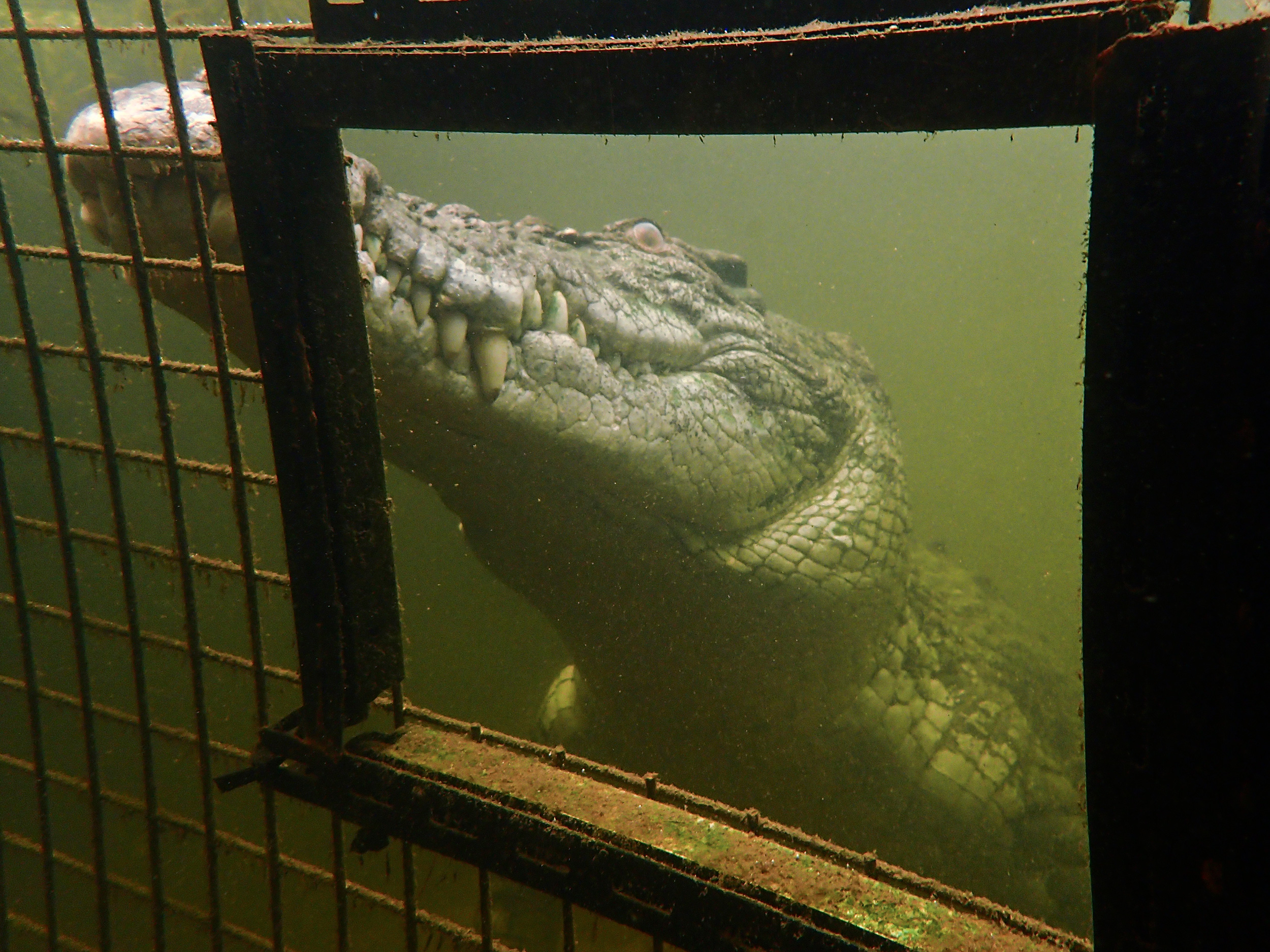
Smaug, once a “problem crocodile,” now lives in a constructed habitat on zoologist Adam Britton’s property. Photo by Shanna Baker
This particular crocodile is a movie star named Smaug. He regularly features in documentaries and has his own Facebook page. Britton, his public relations manager—and owner—feeds Smaug and his mate, Esther, whole chickens or dingoes, buffalo legs, pig parts, wallabies, sometimes even road kill, every week, so he may not be hungry. But does that matter—could he resist the primal urge to attack?
Saltwater crocodiles have had 100 million years to perfect themselves into the ultimate semiaquatic stealth predator. Their killer instincts are so acute that sometimes, Nichols says, they’ll rip apart a victim and not even eat it. They can hold their breath and remain motionless for up to an hour. Special sensory pits around their mouths help them detect motion and attack with precision—a saltie can even snag a bird in flight. They can strike from a resting state in 1/100th of a second, and their jaws are the most powerful of any animal ever measured.
Zoologist Adam Britton introduces his pet crocodile Smaug.
As one local puts it, “They make American alligators look like pussies.”
Among the saltie’s impressive adaptations is its ability to heal its battle wounds quickly and without infection—which could give people another good reason to appreciate crocodiles. Mark Merchant, a biochemist with Louisiana’s McNeese State University, has isolated and synthesized two proteins found in the blood of crocodiles, alligators, and caimans, and is working on developing a potent, topical general antibiotic for human use that’s effective against even drug-resistant bacteria. “There’s probably a lot more discoveries to be made about crocodiles,” says Britton.
For all of its killing prowess, the saltwater crocodile, the biggest of the 24 crocodile species worldwide, is not the worst offender—the Nile crocodile in Africa kills a lot more people. Britton is a cofounder of a new online database called CrocBITE, designed to quantify attacks by crocodiles worldwide. Since 1971, he reports, there have been 21 fatal and 49 non-fatal confirmed attacks by saltwater crocodiles in the NT, with an average of three attacks a year for the past decade—though they’re randomly distributed and sometimes come in clusters. In 2014, there were four fatal attacks. In 2015, zero. The NT government runs an ambitious educational initiative called Be Crocwise in conjunction with the management program, reminding people repeatedly about the risks, which has likely helped keep those numbers down. “When you think about it, one fatality a year or even two a year is nothing—it’s very, very low risk to people in general from crocodiles,” Britton says. They are, of course, a threat, he clarifies, but “if crocodiles were as aggressive and dangerous as people think, there’d be dozens of people killed here every week.” Just as society accepts that crashes on the road are an unfortunate but unavoidable side effect of having a transportation system, Territorians who want the advantages of having crocodiles around need to accept that the price they’ll pay is the occasional fatality, he says. “No matter how good your management program is, as long as there are crocodiles there and as long as there are people there, then at some point someone is going to get attacked by a crocodile.” The experts are quick to point out that we expose ourselves to greater risks everyday—a person in the NT is 15 times more likely to die in a car accident than get attacked by a crocodile.
And yet it’s not so easy to rationalize away the fear, disproportionate as it may be. There’s something a lot more repulsive about the thought of being eaten—your bones crunching, tendons snapping, flesh tearing—than dying in a crash. Britton suspects the difference boils down to a sense of control. Clark Barrett, an anthropologist with the University of California, Los Angeles, who studies cognitive development from an evolutionary psychology perspective, suggests it’s more a case of hardwiring. “Predators have been a threat to our ancestors since well before we were human,” he explains in an email. “Predation is a major reason for primates living in social groups, and large parts of our brain are organized around the dangers of predation. Automobiles, planes, electric sockets, and so on are all evolutionarily more recent, and there are no adaptations in the brain for dealing with them. Predators, on the other hand, are something to which we’re highly attuned.” In terms of adaptations, avoiding a predator isn’t that different than staying away from, say, cliffs, or sharp objects, or poisons, or cracks in the ice, except that only the predator actively seeks you out.
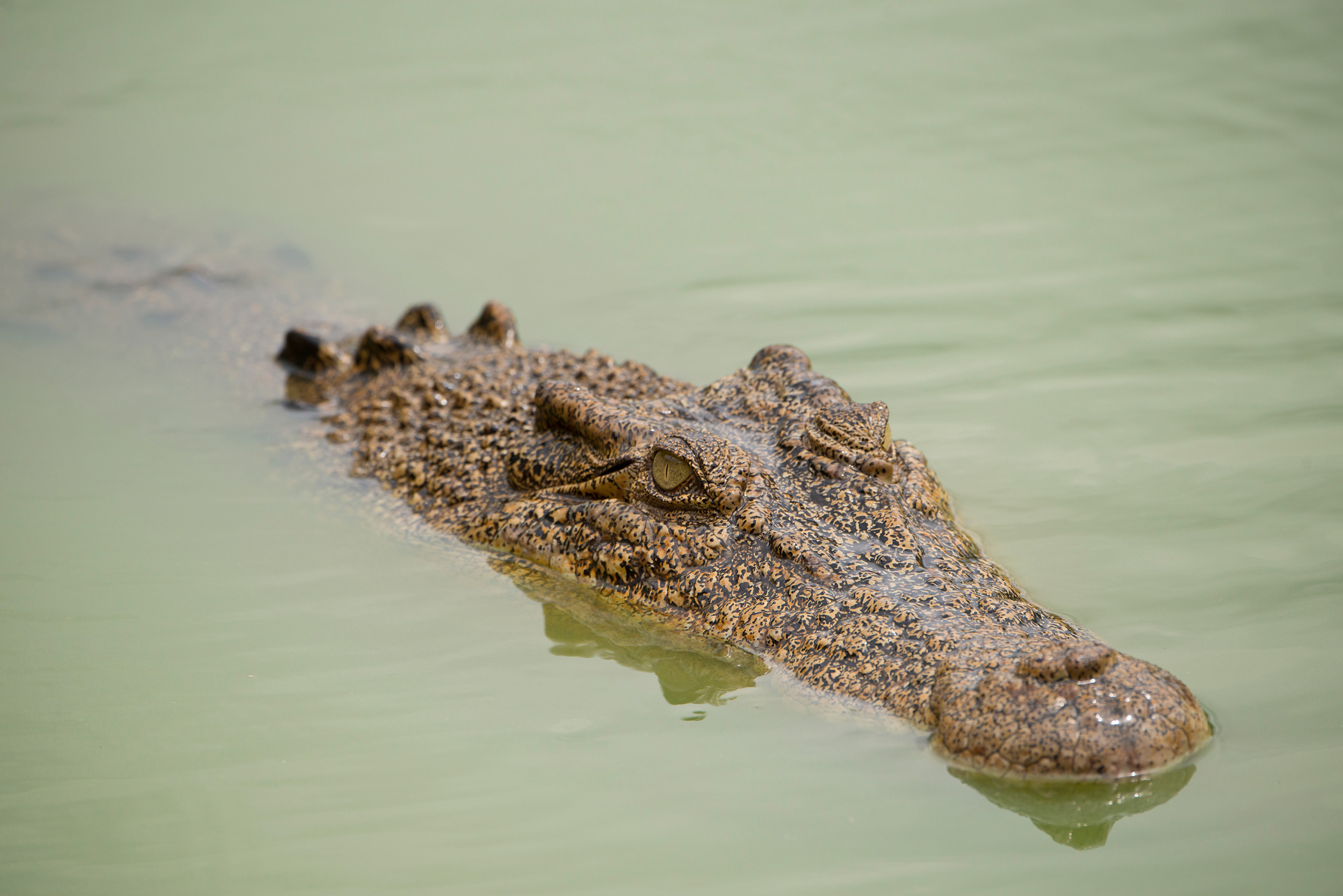
A saltwater crocodile keeps a close eye on a boatful of tourists at Crocodylus Park. Saltwater crocodiles can learn patterns, and local wisdom dictates that you should never repeat the same action at the same spot along the water more than twice. Photo by Shanna Baker
Chris Keeping knows how it feels to suddenly find yourself on the wrong end of the food chain. The stocky 30-year-old with a clean-shaven head and a reddish-blond no-’stache goatee is among the contingent of people who grew up in Darwin and are steeped in knowledge about crocodiles but refuse to be caged by fear.
He was attacked while kiteboarding off Lee Point, roughly 17 kilometers northeast of the city center last May. His friends had told him he was crazy for getting in the water, “but half of them envied me.” He craves the rush of skimming across the ocean’s surface, the solitude of being out there alone with his kite and board. “You get to see a part of the harbor that no one else really sees. … We actually have really awesome beaches and all we use them for is walking dogs.”
The tide was out and Keeping, who was still learning his sport, was in an area frequented by Darwin’s small kiteboarding community but farther offshore than usual, maybe 100 meters, in a deep channel he had turned into by accident. The wind suddenly died down and he was stuck floating not far from the mouth of Buffalo Creek. He realized immediately that if ever he was going to get attacked by a crocodile or a shark, this would be the prime situation for it. He looked around, but didn’t see the crocodile coming until its dark snout had suddenly rolled up on his right side. He jerked to the left and the crocodile snapped down over his shoulder, pinning his arm across his chest, and started to shake him violently. He went limp, too terrified to move, and all he could see at that point was water sloshing over his head. “The first thing I thought is, this is where I die. … Automatically, I thought of my parents. Sorry, Mom. Sorry, Dad. I’m sorry for being so stupid.”
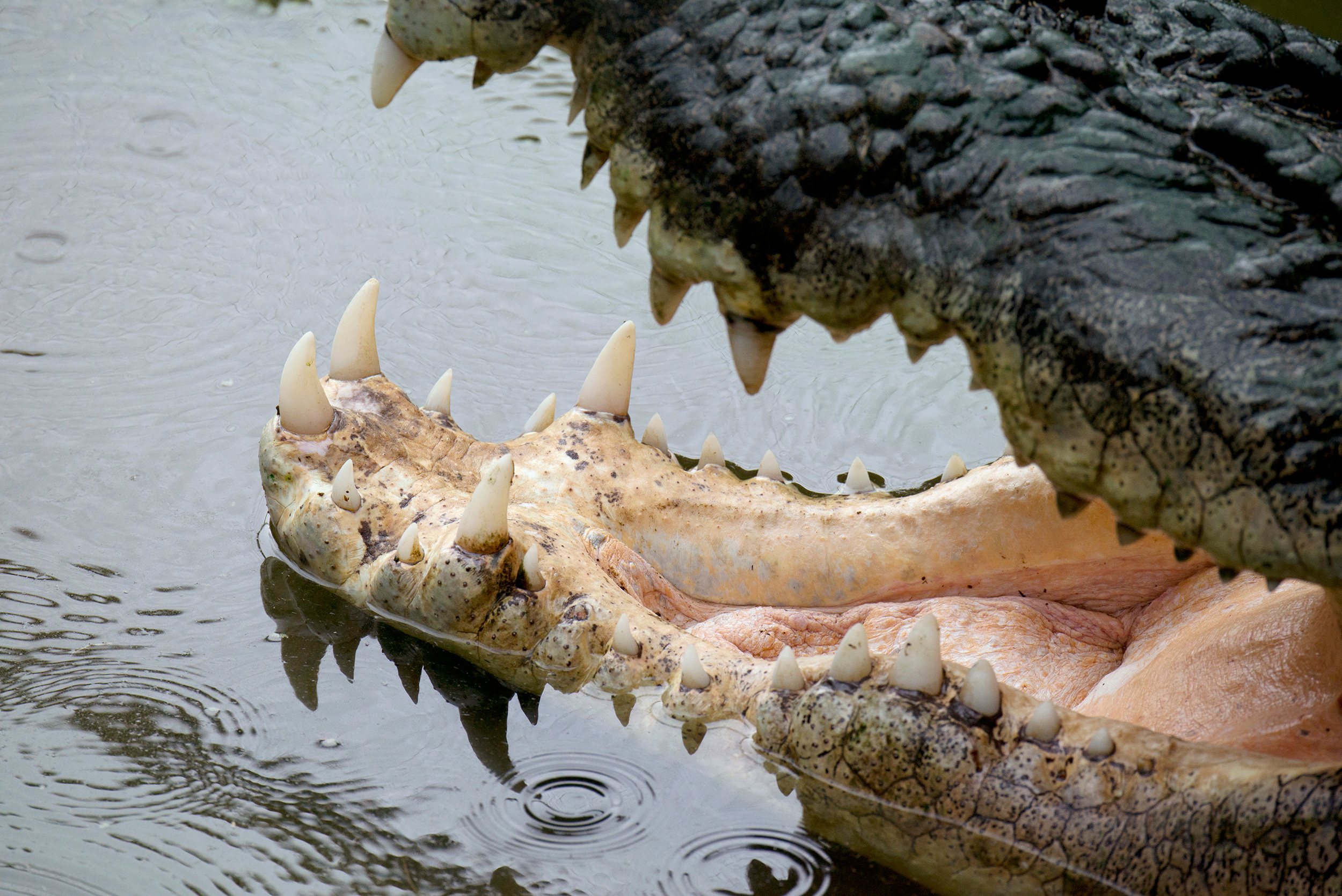
Saltwater crocodiles, which have the highest bite force ever recorded, can easily crush even the toughest prey. They have one or two spare teeth in reserve for each existing tooth. Photo by Shanna Baker
Anticipating that the crocodile might release him to get a better grip, Keeping put his hand against the animal’s snout, hoping he could push off when its mouth opened. The two bobbed in the water like that, gripping one another, for minutes. Then, he slowly reached up and, when he felt the crocodile’s eye retract, plunged his finger into the socket.
In a flash, the crocodile let go and spun away, swam a few meters, and then did a 180, ready to charge again. Keeping slipped off his kiteboard and drew it back just as the crocodile reached striking distance. “I thought, fuck it, if I’m going to die, I’m going to hurt him as much as possible. If they find my body on the beach, when they catch this guy he’s going to have cuts and scars.” He smashed his board, over and over again across the crocodile’s head before it turned away again, swam a few strokes, and then came back for another round. Still dragging his kite, Keeping started back pedaling toward shore, fending off the croc again and again, maybe six times, before finally touching sand, where he could walk backward, thrusting his board like a shield into the water in front of him, and the croc disappeared.
Keeping’s assailant was estimated at 2.2 to 2.5 meters long. If it had been as big as Smaug, Keeping’s story likely wouldn’t have had a happy ending. A saltie’s ability to take down prey is directly proportional to its own body size. “If you get grabbed by a croc of four meters, you are dead,” Webb says. “But if you get grabbed by one that’s three meters, you have a reasonable chance of getting out.” Salties can live 70 years, maybe more, and continue growing until middle age, so although the population size may be nearing its peak, animals born after protection are still getting bigger, so the overall mean size is increasing. Eventually, the crocodile community will even out, says Webb, with a proportionate number of small, medium, and large animals, but in the meantime, with more big crocs, the risk of fatal attacks could escalate.
People recognize that crocs are important to their community and deserve kudos for thriving since long before humans showed up as a blip on the evolutionary timeline, sure, but some would still prefer to remind crocodiles that we’re letting them live. There’s a popular theory circulating among locals that people should start shooting at crocodiles, not to kill them, but to upend the fear imbalance, make them as wary as they were back in the 1960s when hardly any were left and the only ones that survived disappeared at the sight or sound of a human.
When I bring this up with Webb he holds up his hands: “Next question.”
In his mind, it is a ridiculous idea for too many reasons. People have a much better chance of avoiding a crocodile they see lying on a bank than one hiding in the water. And, he says, it’s not feasible to instill fear at the population scale. “You might make some individual croc fearful by beating the shit out of it, but then you have animal rights people up your ass, too,” he says. “That’s not the answer, the answer’s to know what you’re dealing with and moderate your behavior.” The reason crocodiles were so cautious in the ’60s, he believes, is that the bolder animals had all been weeded out: “Suddenly, wariness, which had probably been a bad trait, became the only trait to have.”
William Saalfeld, the scientist who now writes, manages, and oversees the NT’s saltwater crocodile management program, doesn’t dismiss the idea so readily. His interpretation is that crocodiles did learn to fear humans during the hunting era—that wariness is not an innate trait—and have slowly grown more audacious over time. But where the experts agree is that shooting at crocodiles isn’t going to reduce risk one bit.
Then there are those calling for more extreme action, sick of allowing crocodiles to have free rein in the waterways. “We’re getting to the point once more in Australia with attacks and the like such that there are becoming more vocal calls for a broad-scale, major-culling program,” Saalfeld says. After Keeping’s croc encounter, Saalfeld’s minister’s office saw a spike in complaints from the public. “Suggestions were that we have a daily helicopter patrol of the coastline from here to here and every crocodile sighted to be shot on sight,” he says, indicating a stretch of coastline close to Darwin. “That sort of thing.”
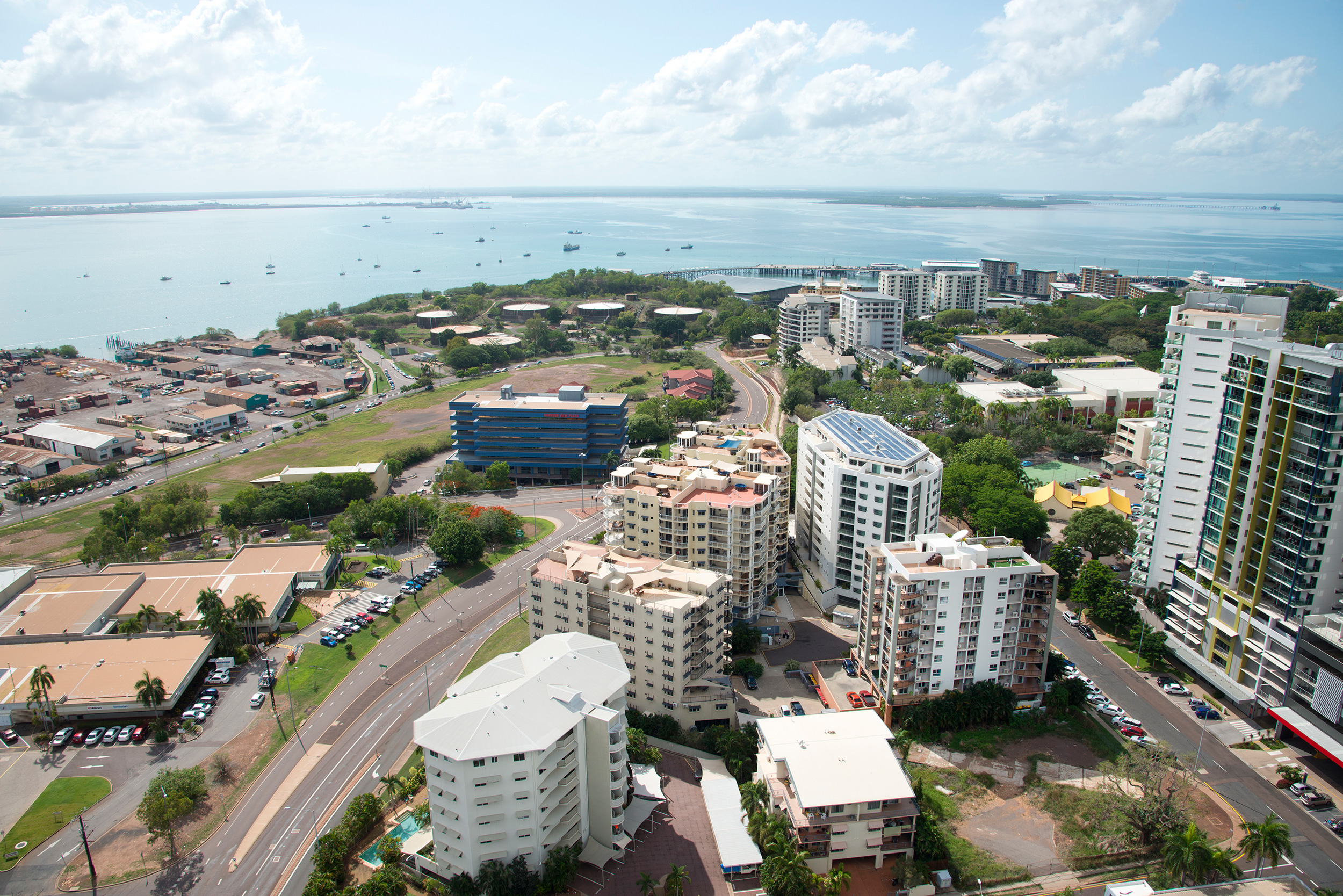
The city of Darwin hugs the Timor Sea in the very northern reaches of Australia—crocodile country. Photo by Shanna Baker
The demands for drastic action aren’t all that surprising, but the experts posit that all it would take to upset the careful balance the management program has achieved is one misinformed politician looking to please some constituents.
If a few big crocodiles are killed, Webb says, that only opens up more habitat, which could actually stimulate an increase in the population. “It is crocodiles that are controlling the size of the wild crocodile population.” To measurably decrease risk for people, crocodiles would have to be knocked back to pre-protection levels. That means killing some 97,000 animals. Not only would that seriously undermine Australia’s global reputation for good conservation, the industry that so many people depend on would crumble. “We now have a live industry estimated at $25-million a year, with the potential to increase to a $50-million a year industry within five years, dependent upon the wild population,” says Saalfeld. “The egg harvesting is the basis in foundation of that industry. If that’s removed, the industry will collapse.” Only one of eight farms in the NT could continue to operate with captive breeding alone, but at a reduced capacity. Britton suggests the repercussions on the environment could also be significant. No one studied local fish populations back in the 1970s, when salties were at their low, but studies elsewhere indicate that if crocodiles disappeared, there may be a domino effect on the density, distribution, and diversity of fish species.
“If you’re going to shoot all the crocodiles, the world isn’t going to end,” says Britton. The ecosystem would adapt. “But it is going to have knock-on effects and repercussions that are almost certainly going to affect you.”
There’s one other dark cloud on the horizon, the source of the furrow on Webb’s brow. Saltwater crocodile attacks in Timor-Leste and Indonesia, 600 kilometers to the northwest, across the Timor Sea, have increased dramatically, with an estimated 120 since 2006, half of them fatal. Timor-Leste has been particularly hard hit, with some 50 reported attacks since 2006 (and likely more that went unrecorded). When Webb visited in 2014 at the request of the president who was seeking help with the growing problem, locals suggested to him that the crocodiles plucking people off the shores of Timor-Leste and beyond could be a byproduct of Australia’s successful conservation initiatives. Webb studied the maps and stats and made the sickening realization that they might be right. A crocodile that’s swimming along the coast of the NT would eventually reach a point at Melville Island, 60 kilometers directly north of Darwin, where it either has to turn 90 degrees to stay in NT waters, or continue in the same direction it’s been traveling for days, he says. “And if it keeps going, it’s going to land in Timor-Leste.” By the time a big male crocodile capable of making that 30-day crossing reached the island of Timor, it would inevitably be thirsty and hungry—a villager casting a fishing net would seem a perfectly snackable size. In Timor-Leste, locals believe their island is the body of a giant benevolent crocodile, and have deep cultural and spiritual ties to the species. The small nation added protection for the sacred animals as it transitioned out of Indonesian control, which was formalized in 2002. Those protective measures may have simply enabled the native population to expand. “You have to look at the null hypothesis and all the reasons you could be wrong,” Webb says. “But I don’t think I’m wrong.”
“I get a bit tangled up with this stuff,” he says. “I don’t know of any cases in any other country in the world where the successful conservation of crocs in one country might be leading to a whole bunch of attacks in another country. It’s new territory politically.”
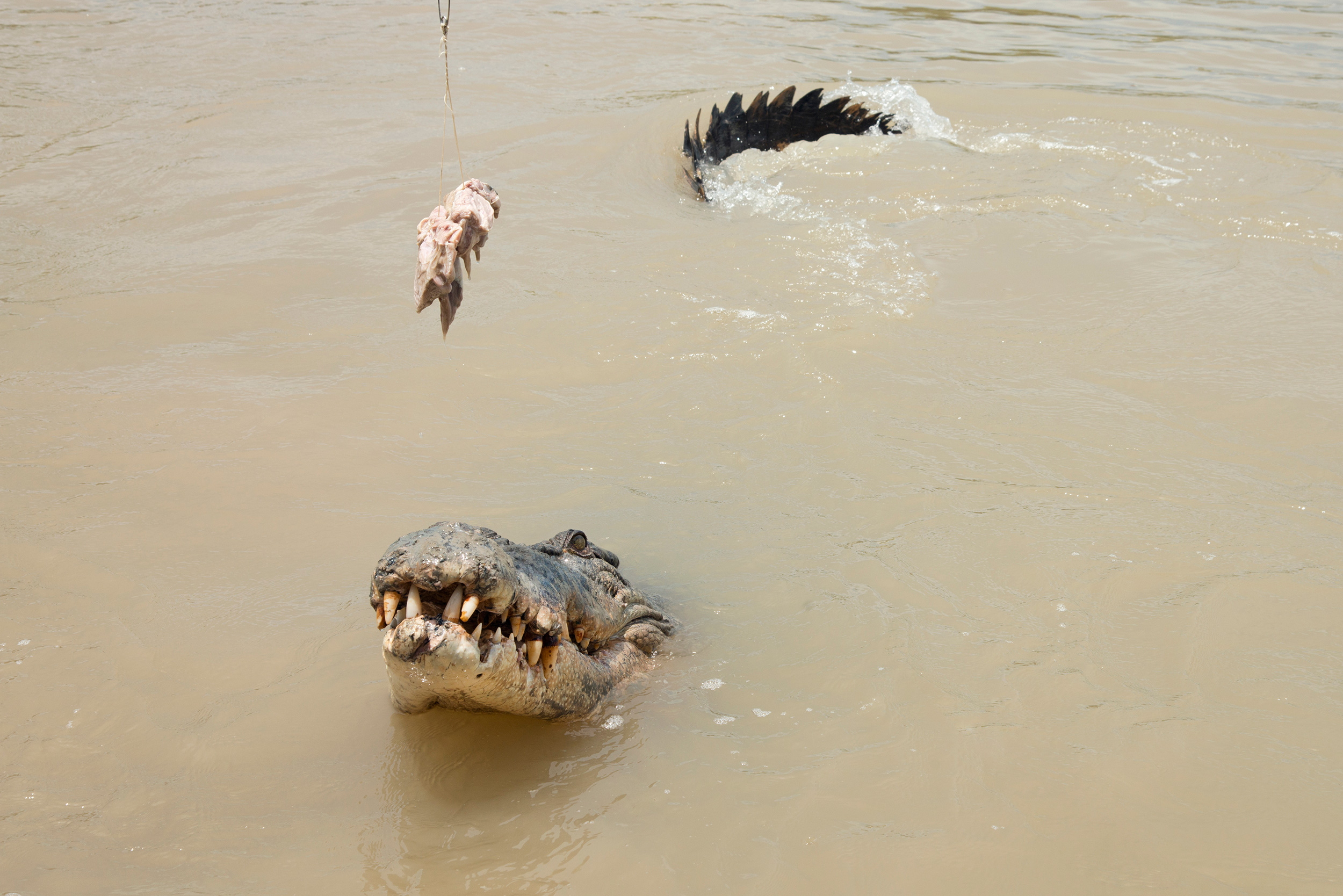
A crocodile prepares to leap for a chunk of buffalo meat dangling from a tourist boat in the Adelaide River. In the water, when a saltwater croc lifts its head, it often raises its tail as a counterbalance. Photo by Shanna Baker
The problem needs serious funding, and fast, he says, so that scientists can launch an investigation and objectively determine what’s happening before more people get killed or there’s a clumsy response. “I’m worried about the implications because crocodile management is a complex sort of issue. … You’ve got to be careful because this sort of stuff leads to knee-jerk reactions,” Webb says. The NT is already a case study in sustainable use; if it’s true that Australian salties are now migrating north, the conservation community will surely take note. The situation, and the response to it, could have far-reaching implications for predator conservation.
On my last day in Darwin, I notice a half-dozen tents set up near a small saltwater swimming lagoon protected with stinger nets and wander over to the Be Crocwise tent, where a ranger is mid-conversation with a young boy. “Crocodiles aren’t bad, but they do eat people,” he explains. The event is about storm preparedness, but the Be Crocwise team attends as many public gatherings as possible. I chat with park guide and longtime Territorian Megan Pohlner about the risks she sees people take in crocodile country. She tries to warn them, but not everyone wants to hear it. “A lot of people think it won’t happen to them,” she says. And despite all of the educational efforts, misinformation is difficult to eradicate. Fishermen like to believe that crocodiles can’t bite underwater without drowning, so they’ll stand in a river up to their knees expecting they’ll see a crocodile coming across the surface and otherwise they’re safe. In fact, crocs have a special valve that allows them to open wide underwater without any problem. It’s inevitable that people will get complacent about dangers. If you smoke a thousand cigarettes, what’s the chance that it’s the one in your hand right now that will give you cancer.
“We are really living with them,” Pohlner says. “They’re right here.” On a scorching day like this, when the temperature’s climbing past 36 °C, the most natural thing for a person to want to do is fling off her sandals and plunge headlong into the Timor Sea. “Sometimes I wish I could get in there,” Pohlner says. “But I can’t. I won’t—it’s a lifestyle choice. I put a pool in our backyard. Like every animal, I’m making adaptations.”
There’s no question the NT’s Top End would be less enthralling or seductive without crocodiles. They are the mojo, the special ingredient that makes the place unique. The current management program and educational efforts are, the experts believe, working as well as can be expected, both at keeping people safe and encouraging them to keep crocodiles around. But the relationship between crocodiles and humans will always be dynamic. What if the super-rich someday turn their noses up at crocodile skin. Or the people of Indonesia and Timor-Leste start pointing fingers at Australia, demanding drastic action. Whether the relative harmony can be maintained for generations to come is anyone’s guess, but there’ll surely be more battles to come.
Beyond the row of tents, a giant grinning inflatable crocodile has been set up for the event. Small, squealing children take turns sprinting and flinging themselves into the crocodile’s mouth and down its throat.

